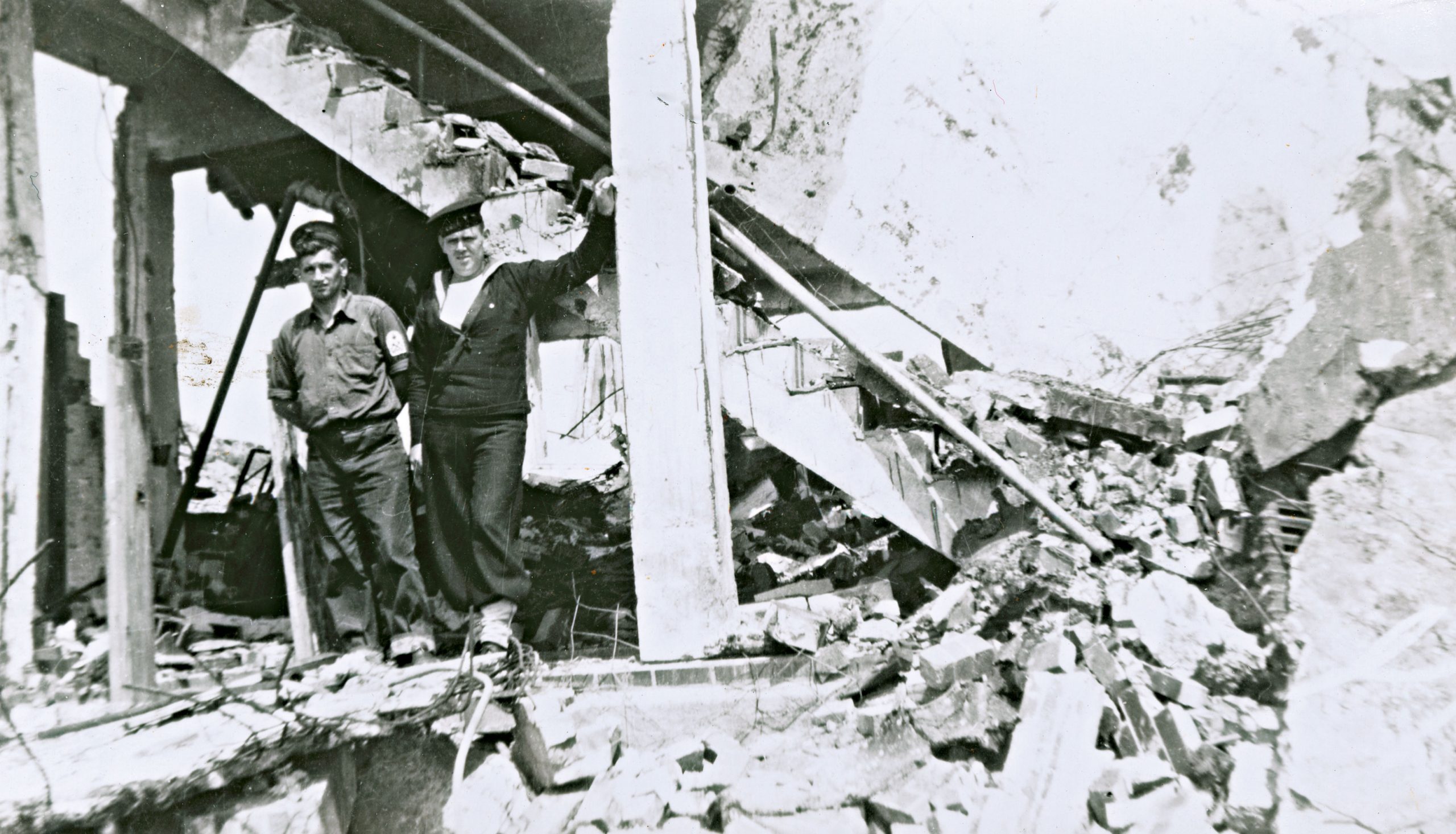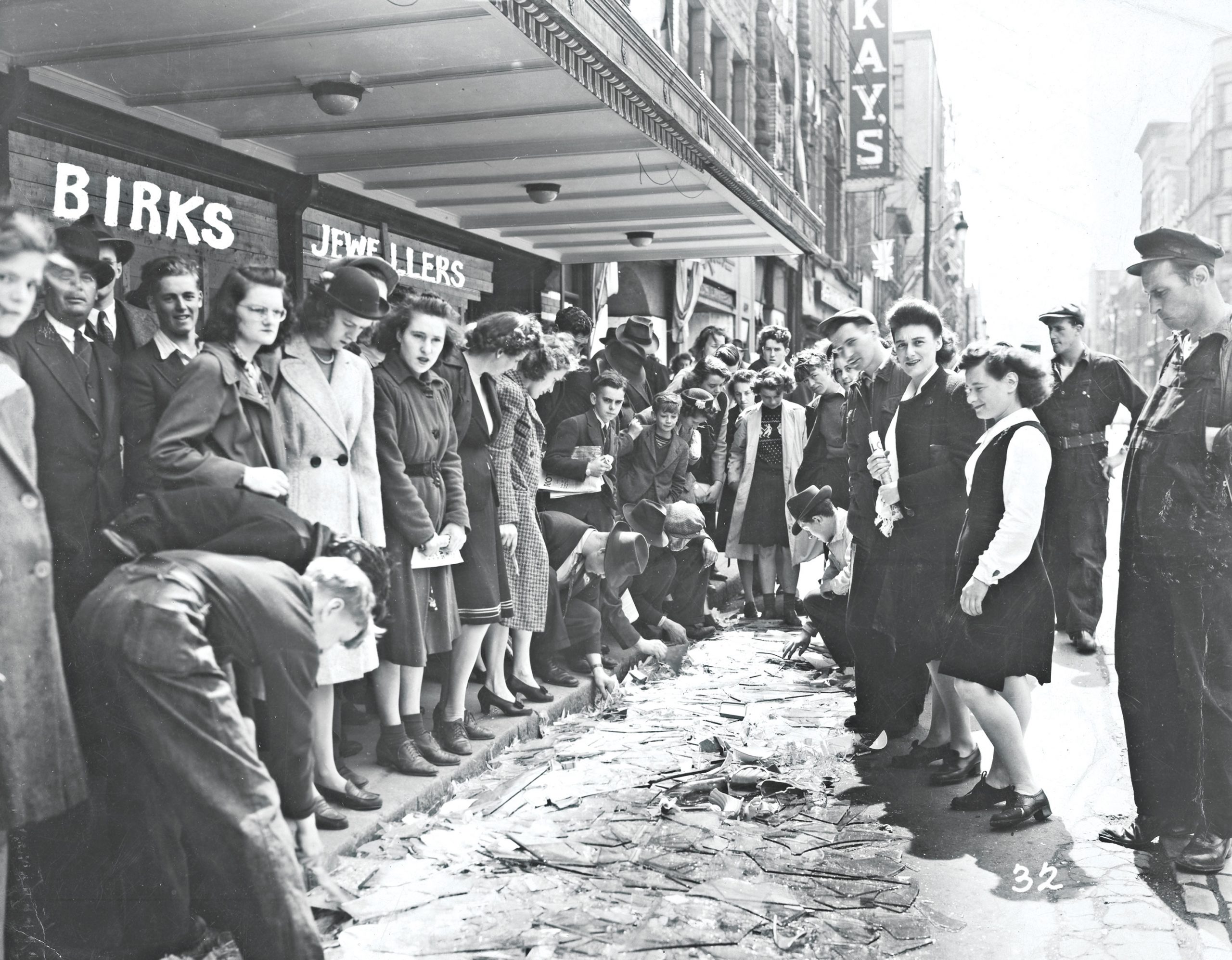
A montage merges the moment of the explosion with the aftermath. [Estate of Ralph W. Kane/Nova Scotia Archives/4541]

When the Second World War broke out, residents of Halifax and Dartmouth—carrying vivid memories of the disastrous explosion of 1917—were understandably nervous. And the danger this time was even greater than it had been a generation earlier. The same enemy was much stronger and his reach—particularly by sea—was much longer.
Unprecedented wartime expansion of the Royal Canadian Navy brought more and larger warships than in the First World War, all laden with ammunition. These vessels sailed in and out of Halifax Harbour daily, tying up alongside in HMC Dockyard, the naval base close to the city centre on the western side of Halifax Harbour at the southern end of The Narrows.
The convoys forming up in the sheltered waters of Bedford Basin were also larger, more frequent and far more dangerous than those of the First World War. There was ample fear that another explosion would occur.
It did, but it happened two months after the war in Europe had ended.

A chain reaction of fire and explosions tore through the munitions storage facility, leaving a wake of destruction. [Estate of Ralph W. Kane/Nova Scotia Archives/4541]
Stretching for five kilometres along the eastern shore of Bedford Basin on an 800-metre-wide property, the Bedford Magazine (now named Canadian Forces Ammunition Depot Bedford) consisted of a series of small, well-ventilated brick structures designed to store shells and other explosives. Each was surrounded by protective earth and concrete berms.
The magazine was so heavily overused at the time that it was impossible to fully observe all safety regulations. When the war ended, the situation became far worse.
Masses of ammunition unloaded from returning warships were stacked on the wharf. The federal government applied political pressure to get the ships unloaded as rapidly as possible so their crews could be sent home. Safety regulations were disregarded in the name of expediency.
In particular, each jetty should have contained just one ship’s ammunition at a time, but ammunition from three ships was
frequently piled together, stacked up to two metres high.

The middle of July brought a heat wave to the area, leaving brush, grass and leaves highly flammable. About 6:30 p.m. on July 18, a fire broke out in a barge tied up at the magazine’s south jetty. It was later believed to have been caused by a pyrotechnic flare that leaked and then burst into flame.
Able Seaman Henry Craig spotted the fire and yelled to a mate, “I’m going down to see if I can put it out!” He had just reached the end of the jetty when the whole structure blew up. His body was found three days later, hurled about 180 metres inland.
The fire spread rapidly and set off a sequence of explosions that threatened to blow up all the ammunition stored there—and take a large part of the city with it.
Commander Owen (Long Robbie) Robertson, the King’s Harbourmaster, had just started dinner with his wife in the Nova Scotian Hotel when “there was a bang and all of the dust came out of the ventilators.” He rushed to a top-floor room overlooking the harbour and saw “a mushroom cloud over the magazine!”

A crowd examines a pile of broken glass outside a jewelry store on Barrington Street in Halifax after the fire and explosions. [Estate of Ralph W. Kane/Nova Scotia Archives/4544]
Robertson headed for the dock, where a boat took him across the harbour to the magazine. He intended to land at the south jetty but when he got there, “the jetty had disappeared.” He landed at the north jetty and went ashore to assess the situation. It was not good.
“The south end had gone,” he reported. “The buildings were gone. The water tower had come down.” About a third to half of the older part of the magazine—perhaps 160 hectares—was in ruins.

Robertson was put in charge of all firefighting efforts: military and civilian, full-time and volunteer. He feared the worst—a repeat of the devastating 1917 explosion. As a safety precaution, he called for the evacuation of all residents north of Quinpool Road in Halifax, along the Bedford Highway and in the north end of Dartmouth. Thousands of people were moved away. Several civilian and naval ships weighed anchor and moved out of range. Others were pushed out of the way by tugs or towed by other ships.

A mushroom-shaped cloud erupts from the Bedford Magazine jetty on the evening of July 18, 1945. [Jay C.M. Hayward/Yarmouth County Historical Society/Nova Scotia Archives/1981-517 1]
After Robertson arrived at the site, a nearby reinforced concrete building suddenly blew up, tossing him into a pond. Fortunately, he was uninjured.
The magazine’s water main had been destroyed in the first blast, so firefighters had to pump water from water tanks and a nearby stream. They eventually succeeded in flooding the newer magazines to prevent further explosions.

The roadway leading to the south jetty is littered with debris.[Jay C.M. Hayward/Nova Scotia Archives]
Exploding shells and bullets drove the firefighting teams to the ground as they battled the tenacious blaze. Shells separated, with bullets going one way and casings going another. Several firefighters got hit, “but all they did was make you black and blue,” said one. “Some of the smaller ones were going so slowly that you could catch a 20-millimetre round in your hand. But not gracefully.”
The heat, heavy work and lack of food and water soon dehydrated Robertson and his men. He radioed headquarters for something to be sent for his hungry workers.
“What we would have welcomed was lettuce and ice cream—maybe sandwiches—but good old Central Victualling Depot sent us a slab of beef and a sack of raw potatoes.”

[Jay C.M. Hayward/Nova Scotia Archives/1981-517 2]
Robertson was furious and, after 24 hours without sleep, more than a little irritable. He got on the radio again, this time on an open channel, cursed whoever was in charge of the depot and threatened to “have this guy’s balls for a necktie.” Ice cream and sandwiches soon arrived.
After two nerve-racking days of superhuman efforts, Robertson and his men saved Halifax from a potentially disastrous repetition of the 1917 explosion.
Damage was largely limited to shattered windows, broken plaster, downed power lines and cracked foundations. Miraculously, Craig was the only fatality. He was awarded a posthumous Mention in Dispatches “for outstanding valour in the face of fire.”
Advertisement


















